If you’re like most RV owners, keeping your roof clean is probably near the bottom of your list of priorities. But did you know that a dirty roof can actually cause damage to your vehicle? Not to mention, it can be downright unsightly. In this article, we’ll provide you with a comprehensive guide to cleaning your RV roof. We’ll answer some common questions and offer some useful tips that will make the process a lot easier (and less time-consuming) for you. So read on and get started!
Table of Contents
Types of RV Roofs
RV roofs come in a variety of types, including rubber, aluminum, and fiberglass. Each type is unique and requires its own special cleaning technique.
These materials need to be cleaned with gentle cleaners and soft brushes or sponges so as not to damage them.
Aluminum RV roofs need to be cleaned with an effective cleaner that will remove any dirt, grime, oxidation, or other buildups on the surface. A soft brush can also be used to scrub away stubborn areas.
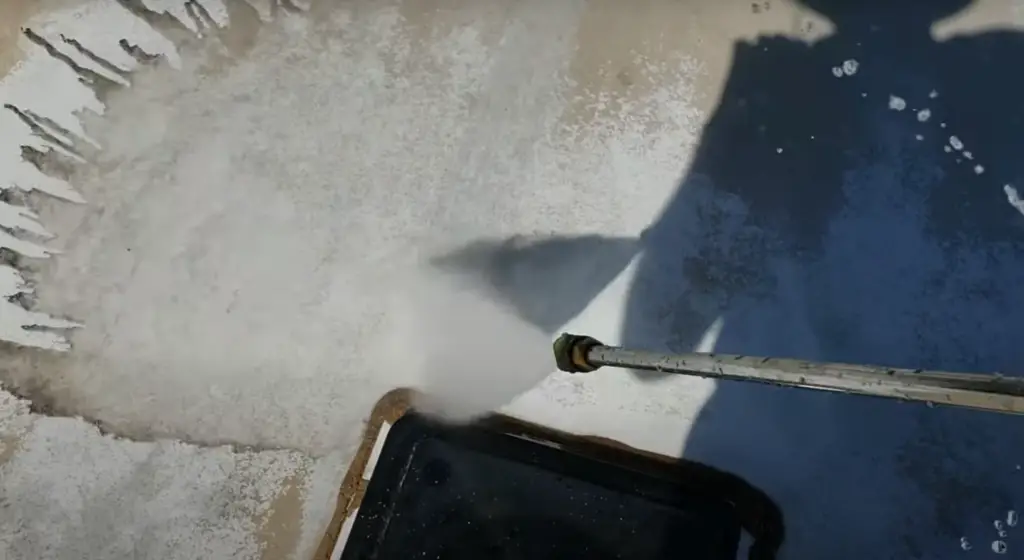
Fiberglass RV roofs require special cleaners to help remove the oxidized layers of the surface. These types of cleaners are specifically designed to clean fiberglass surfaces, so it is important to choose the right one for your RV. [1]
Why is it Important to Clean an RV Rubber Roof?
Regularly cleaning an RV’s rubber roof can help maintain its longevity and keep it looking great.
In addition, dirt, debris, and other materials that accumulate on the roof can cause issues with water drainage and create standing water. This standing water increases the chances of mold growth which could lead to serious damage to your vehicle’s interior.
Cleaning your RV’s rubber roof regularly will not only make your rig look better but also extend the life of your roof by preventing issues from developing in the first place. It also helps prevent costly repair bills down the road.
How to Clean an RV Roof?
Once you have identified the type of roof that your RV has, it is time to get started on cleaning. Below are tips and steps for successfully cleaning any type of RV roof.
Ensure Your Safety
Before beginning any project, it’s important to make sure you are safe. Wear protective clothing such as long pants, a long-sleeved shirt, and closed-toe shoes. Additionally, use safety goggles and gloves when handling cleaning chemicals.
Gather Materials
Next, gather the materials that you will need for the job: a garden hose with an adjustable nozzle; a scrub brush; cleaning chemicals (detergent or bleach); and a ladder if your RV is too high to reach from the ground. Once all of your materials are assembled, check your roof one more time for any debris that may have contained water or dirt. If there is debris on the roof, use the garden hose
Sweep Your RV Roof & Hose It Down
Before you get started, make sure to give your roof a good sweeping first. Use a broom with stiff bristles to remove any dirt and debris that has collected on the surface. Be careful not to scratch or damage the roof as you sweep.
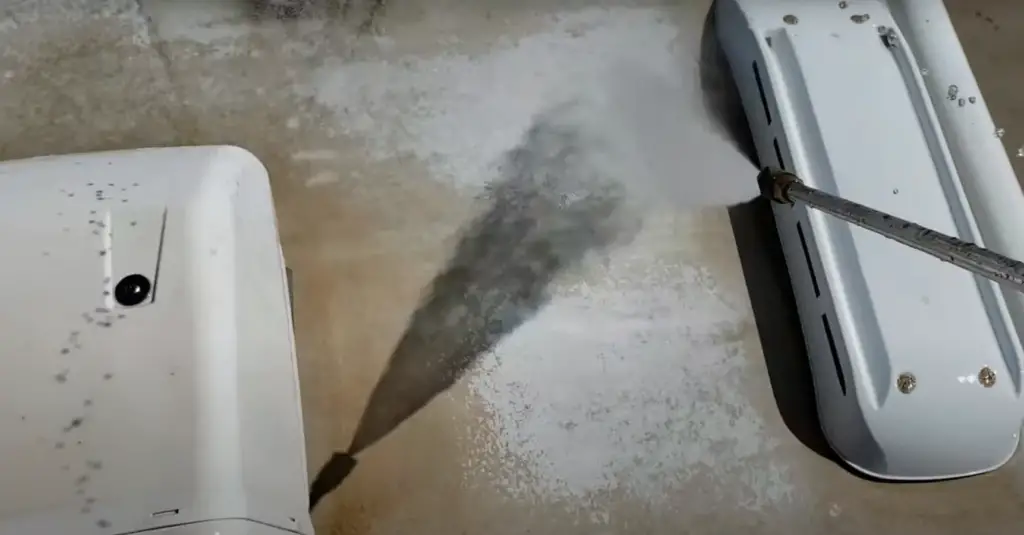
Once you’ve swept away any loose material, it’s time to hose down your RV roof. This will help remove stubborn dirt and grime that won’t budge with just sweeping alone. Make sure to use lukewarm water when hosing off the roof; hot water can actually cause damage if used in excessive amounts. Aim the stream of water from the hose at an angle rather than directly downwards so that it doesn’t force any dirt further into the seams of your RV.
Once you’re done hosing the roof off, it’s time to move on to the next step – applying a cleaning product. It is important to use products that are specifically designed for RV roofs as standard household cleansers can be too harsh and may damage the material on your roof.
Apply a generous amount of cleanser to the surface of your roof and let it sit for several minutes so that it has time to work its magic. After this, rinse off any remaining residue with lukewarm water from your hose.
You should now have a clean, dirt-free RV roof! To maintain its condition, make sure to perform a thorough cleaning at least once a year. Doing so will help ensure that your roof stays in great shape for years to come.
Use the Right Cleaner for Your RV Roof
When it comes to cleaning an RV roof, the most important thing is choosing the right cleaner. While there are a number of products on the market claiming to be specifically designed for this purpose, you should always research each one carefully and read the label before purchasing.
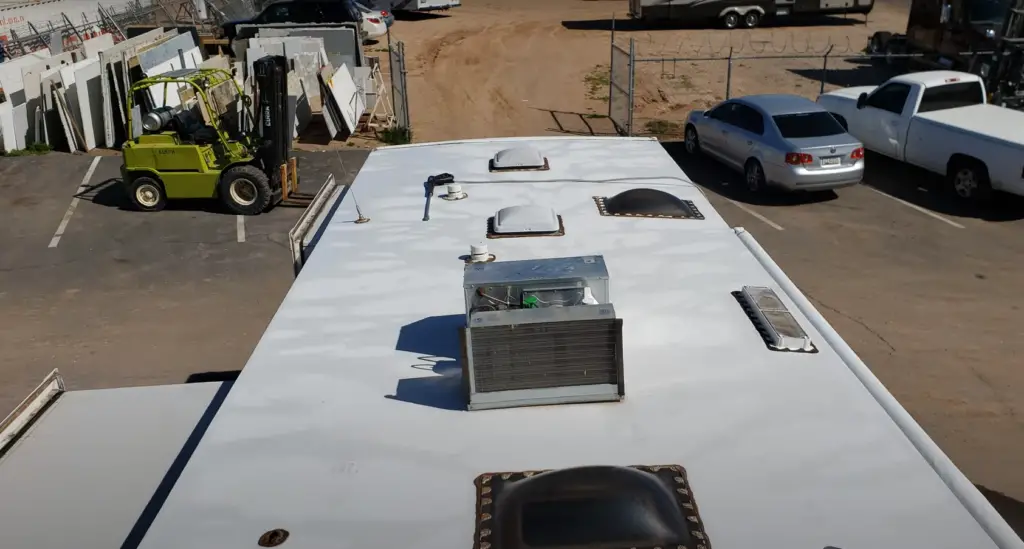
The best way to clean an RV roof is by using a two-step process. First, use a cleaner that will remove dirt, oxidation and other debris while being gentle enough not to harm the surface of your vehicle. Second, use a protective coating such as wax or sealant that will help protect against future damage from UV rays and other environmental elements.
Be sure you choose the correct strength or type of cleaner for your particular model of RV.
How to Clean an EPDM or TPO Rubber RV Roof
EPDM (ethylene propylene diene monomer) and TPO (thermoplastic olefin) roofs are increasingly popular due to their low maintenance requirements. When it comes to cleaning these types of roofing, you can use a mixture of 1/3 cup of detergent or dishwashing liquid mixed with 1 gallon of water.
Start at the top edge of your RV roof and work down, using a soft-bristled brush to scrub away dirt and debris. Rinse off the cleaner completely with clean water after each section is cleaned. Use a cloth or sponge to dry the surface so there is no standing water left on the roof when finished.
How to Clean a PVC RV Roof
If your RV is made with a PVC roof, the cleaning process will be much easier. You can use a mild soap and water solution to clean the surface of your roof. Ensure you rinse off any soapy residue as it can cause damage over time.
If you have stubborn stains on your roof, try using a soft bristle brush and applying some pressure when scrubbing. For more serious stains, such as bird droppings or tree sap, you may need to use a commercial cleaner specifically designed for cleaning vinyl roofs.
When finished cleaning your RV’s PVC roof, make sure that you rinse it off with clean water to remove any soap or chemical residue.
If you have an aluminum or fiberglass roof, you may need to use a different cleaning method that won’t damage the material. Be sure to check your owner’s manual for specific instructions on how to properly clean your RV’s roof.
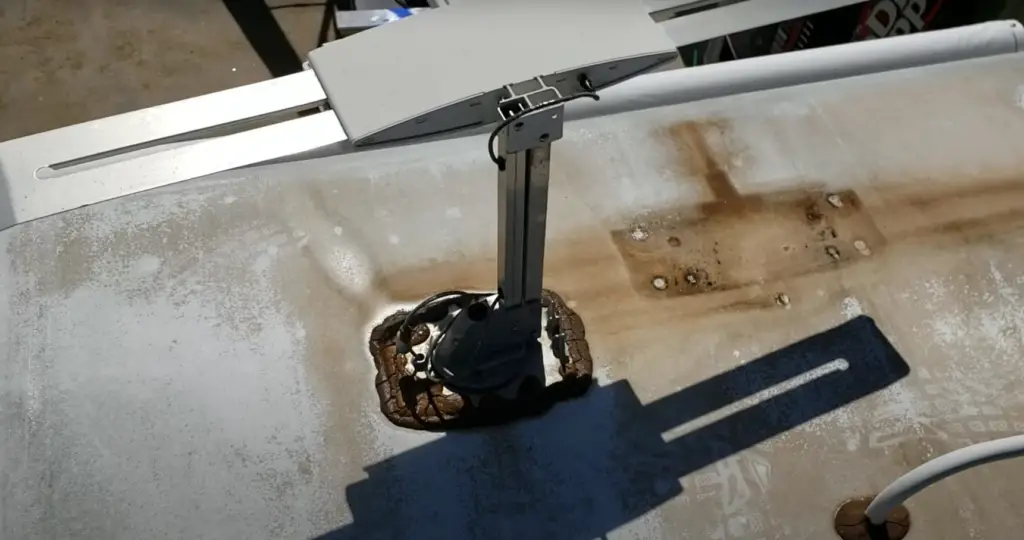
How to Clean a Fiberglass RV Roof
Fiberglass RV roofs are the most common type of roof on recreational vehicles. They’re usually made from a combination of glass fibers and resin, making them strong and durable but also relatively easy to maintain. Here are the steps:
- Start by using a hose or pressure washer to rinse away any loose debris such as leaves, dirt, bird droppings, tree sap and other organic material that may have collected on the roof. This is important because these can damage the surface if they’re not removed first.
- Once you’ve rinsed off any loose materials, use a mild detergent mixed with water in a bucket or spray bottle to thoroughly clean the areas of the roof that have dirt or other build-ups.
- Once the detergent has been applied, use a soft-bristled brush or non-abrasive scrubber to gently scrub away any spots that are still present on the roof.
- If there are any persistent stains, use a specialized cleaner such as an RV roof cleaner to treat them.
- After you’ve finished cleaning the roof, it’s important to rinse thoroughly with water so no soap residue is left behind that could attract dirt and debris in the future.
- Finally, let your fiberglass RV roof dry completely before applying any sealants or coatings for protection against the elements.
How to Clean an Aluminum RV Roof
Aluminum RV roofs are one of the most common types of camper roof materials. They are lightweight and highly durable—the perfect combination for RVs, ensuring a long life for your vehicle. But with that durability comes the need for regular maintenance, which includes cleaning it regularly to prevent dirt and debris buildup. To help you keep your aluminum RV roof in tip-top shape, here’s how to clean it properly:
- Start by mixing water and mild detergent together in a bucket or spray bottle until combined.
- Spray or apply the solution on the roof using a soft cloth or brush, taking care not to scrub too hard as this can cause damage. Allow the solution to sit on the roof for a few minutes.
- Next, use a soft-bristled brush or sponge to scrub the roof in circular motions. This will help loosen any dirt and debris that may have built up on the surface of the RV roof over time.
- Rinse the roof with clean water from a hose or pressure washer, starting from the top and working your way down.
- Allow the roof to air dry before applying any sealant or other protective coating (optional). This will help protect your aluminum RV roof from further damage caused by UV rays, moisture, and extreme temperatures.
Check for Roof Damage & Replace the Sealant
Before you begin cleaning, inspect your RV’s roof for any cracks, tears, or other damage. If there is any noticeable damage, it should be repaired before attempting to clean the roof. This can help prevent further damage from occurring as a result of water seeping through these openings during the cleaning process. If the sealant appears to be cracked or otherwise damaged, replace it with fresh sealant after repairs have been completed.
If everything looks good and no repairs are needed, you’re ready to start cleaning! It’s always recommended to use products specifically designed for RV roofs when cleaning them. These products are safe and effective at getting rid of dirt and grime without damaging the surface of your roof in the process.
Can You Pressure Wash an RV Roof?
Yes, you can. Pressure washing is a great way to easily and quickly remove dirt, debris, and other organic matter from your RV’s roof with minimal effort. However, it’s important to be careful when doing so – too much power or too close of an angle can cause damage to the roof. It’s best to start at a lower pressure setting (around 1500 psi) and move up as needed until you find one that removes the dirt without damaging the surface. Additionally, make sure that you use plenty of soap and water mixture in order to lubricate the surface – this will help protect it against scratches caused by direct contact with the nozzle/brush. Finally, always hold the nozzle at least 12 inches away from the RV surface when pressure washing.
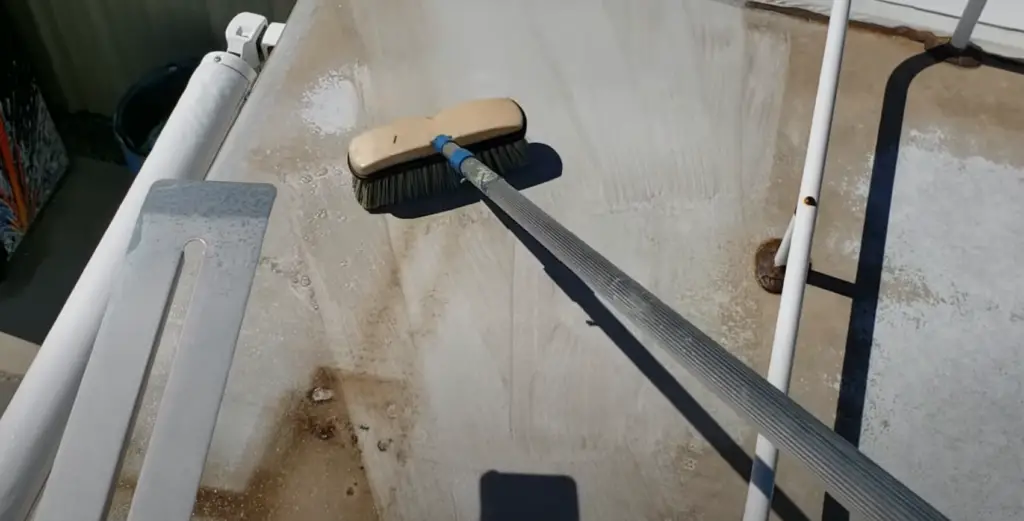
When you’re done pressure washing, it’s important to rinse off any soap residue with clean water. This will help protect against streaking or staining as well as reduce the chance of oxidation on the roof surface over time. Additionally, be sure to let the RV roof completely dry before applying any products or sealants.
How to Remove Tree Sap from an RV Roof
Tree sap can create an unsightly mess on the roof of your RV. To remove it, you’ll need to use a specially formulated cleaning solution for removing tree sap from vehicles. Start by washing your RV with cool water and a car-washing detergent. Then, spray the affected area with the tree sap removal product and let it sit for 5 minutes or longer if the stains are more stubborn. After the time has elapsed, rinse off the cleaning solution with clean water and dry the surface thoroughly using a microfiber cloth. For especially difficult to remove stains, you may have to repeat this process several times before seeing results. Once all visible signs of tree sap have been removed, apply a coat of wax to protect your RV’s roof from further damage.
Can You Clean an RV Rubber Roof with Bleach?
Yes, you can clean a rubber RV roof with bleach. However, it is important to take several safety precautions before beginning any cleaning process. It’s best to wear protective gloves and a face mask in case of contact with the cleaning solution.
Once the area is prepped, mix one part bleach with nine parts water in a bucket and use a soft-bristled brush to scrub away any fading or discoloration on the roof. For tougher spots, apply more pressure while scrubbing them away. Make sure not to let the cleaner sit for too long as this could damage the rubber surface of your RV roof.
After scrubbing, thoroughly rinse the roof off with clean water to remove any remaining bleach residue. Finally, allow the roof to air dry in direct sunlight and inspect it for any signs of discoloration or damage. If you find any suspicious spots, repeat the cleaning process until they disappear.
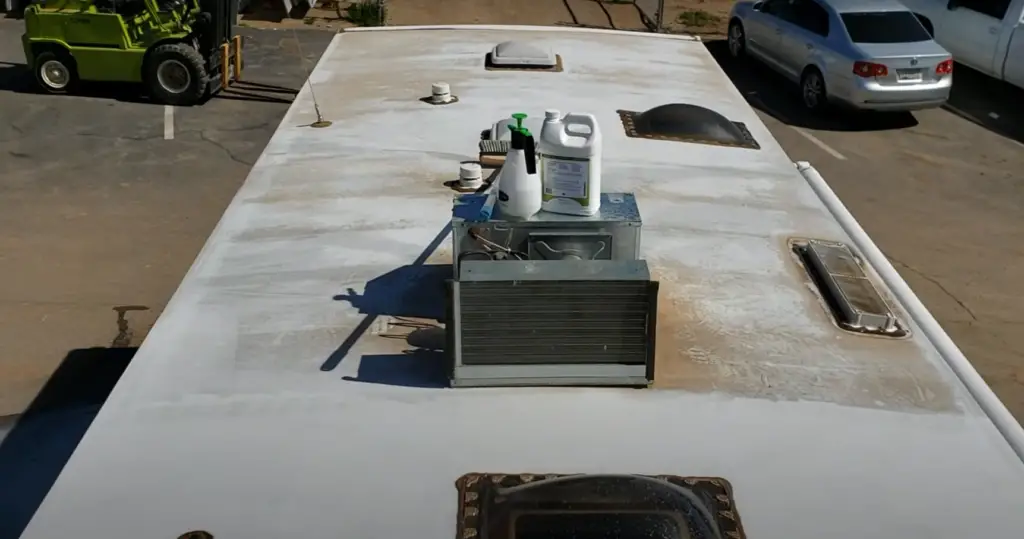
Once your RV roof is completely dry and all discolored spots are gone, apply a protective sealant over the entire surface to protect it from future damage. This additional layer of protection will ensure that your RV roof remains looking like new for years to come. [2]
Cleaning an RV’s rubber roof can seem intimidating at first but with a few simple steps and some basic supplies, it doesn’t have to be. With the right knowledge and preparations, you can keep your RV roof looking good as new.
FAQ
What is the best way to clean a rubber roof?
The best way to clean a rubber roof is with a mixture of mild detergent and lukewarm water. You can also use a gentle brush or sponge to scrub away dirt and debris. It’s important to avoid harsh chemicals or abrasive materials, as these can damage the roof’s surface. After cleaning, rinse off with clean water and dry with a soft cloth. [3]
How often do you need to clean your RV roof?
The answer depends on a few factors, such as the material of your RV roof and where you live. Most experts agree that an RV roof should be cleaned at least once a year to keep it looking good and protected from the elements.
If you live in an area with extreme weather conditions or if you take your RV for trips often, then cleaning more frequently is recommended. In some cases, your roof may need to be cleaned up to three times a year. [4]
How do you remove mildew from an RV rubber roof?
Mildew on an RV rubber roof can be a difficult problem to tackle. First, ensure that your roof is adequately ventilated and kept dry at all times, as this will help prevent mildew from forming in the future. Then, if you do find yourself with mildew on your roof, there are several steps you can take to remove it.
One of the best ways to get rid of mildew is by using a mixture of water and bleach or vinegar. This should be applied directly onto the affected area with a scrub brush or soft cloth. Let the solution sit for 15-20 minutes before rinsing off with a hose or power washer. For more difficult mildew stains, repeat this process. [5]
Another effective way to remove mildew from a rubber roof is by using a commercial cleaner specifically designed for RV roofs. These cleaners can be found at most RV and camping stores. Be sure to follow the instructions on the cleaner carefully, as they can vary depending on the brand.
Once you have removed the mildew from your roof, it’s important to take steps to prevent it from returning. This means keeping your roof clean and dry, as well as ensuring that it is properly ventilated.
How do you get black stains off an RV roof?
Black stains on your RV roof are most likely caused by mildew and mold growth. Use a cleaner specifically formulated for RVs such as Star Brite Non-Skid Deck Cleaner. For optimum results, simply spray the area of concern and let it sit for 10 minutes. Repeat the process a few times if the stains are stubborn. After you’re done, rinse off the cleaner and dry it with a clean rag.
You can also try using household cleaners like baking soda or vinegar. Simply mix one part baking soda (or vinegar) with one part warm water and apply.
If you have stubborn black stains that won’t come off with either of these methods, use bleach. Dilute one part bleach in 10 parts water and apply to the stains. Let it sit for 10 minutes, scrub it with a soft brush, rinse off with fresh water and dry it with a clean rag.
Remember that bleach can damage your RV’s rubber sealant, so use caution and test on a small area.
Ensure to protect yourself by wearing gloves and safety eyewear. Additionally, never apply cleaners directly onto the surface of your RV roof – always spray them on a soft cloth or brush first, then apply them to the surface. This will help prevent streaks and damage to your roof.
With regular inspections and cleaning, you can ensure that your RV roof stays in top shape for years to come.
Useful Video: How To Wash and Wax an RV Like a PRO! New RV Maintenance, Tools, Products and Tips
Conclusion
Cleaning an RV roof is an important task that should be done regularly to help prevent damage and keep your rig looking great. It’s not a difficult job, but the right supplies and techniques are essential. Be sure to use only mild detergents that won’t harm the sealants and protective coatings. Start from the top down and finish with an application of a sealant to help protect your roof from future damage. Happy cleaning!
References
- https://rvjunket.com/types-of-roofs-on-rvs/
- https://www.etrailer.com/faq-how-to-clean-rv-roof.aspx
- https://www.rubber4roofs.co.uk/blog/how-to-care-for-a-flat-rubber-roof
- https://drivinvibin.com/2021/10/30/clean-condition-rv-roof/
- https://rvshare.com/blog/how-to-remove-mold-and-scum-from-your-rvs-exterior/

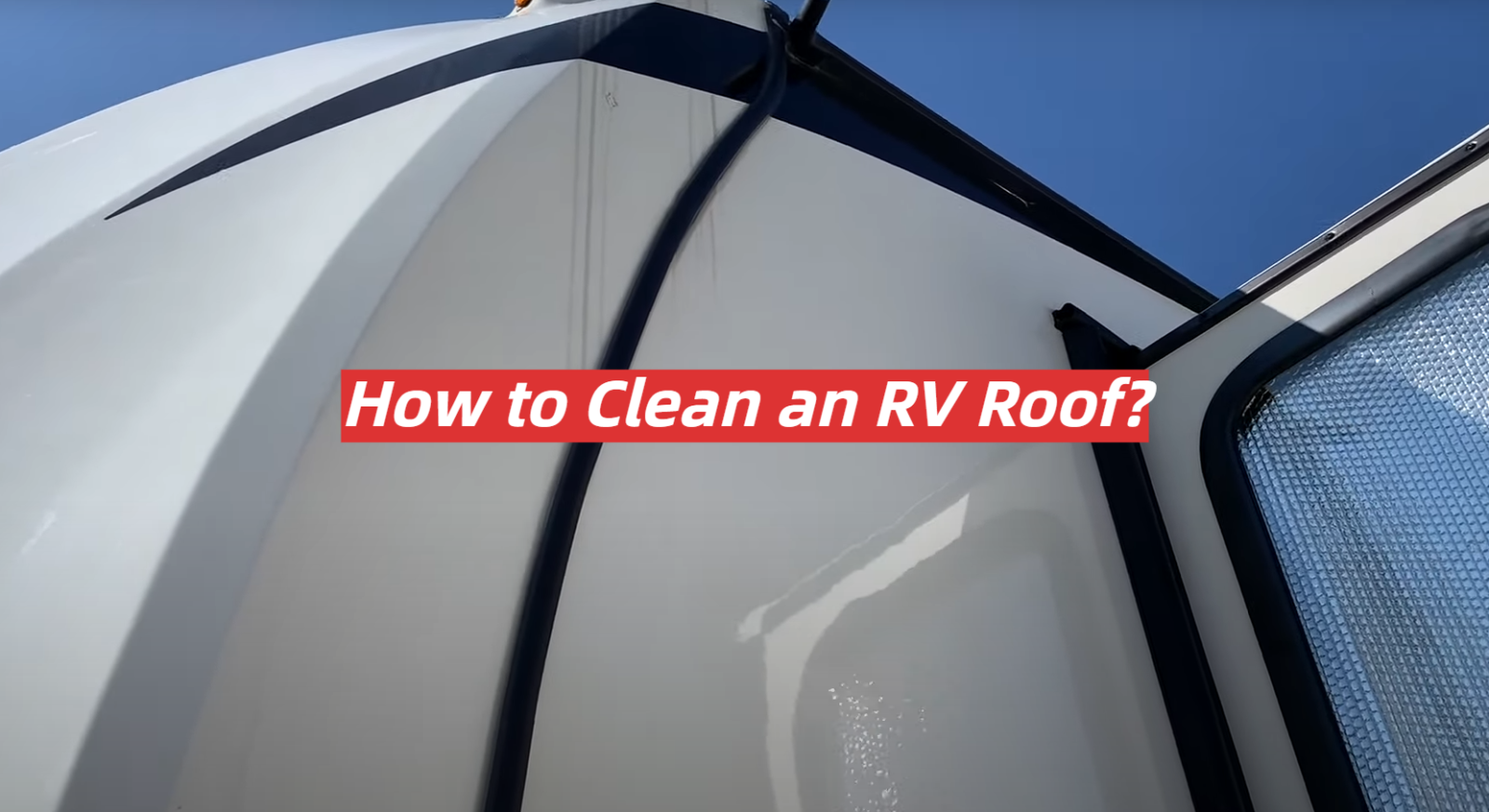
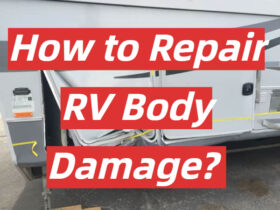
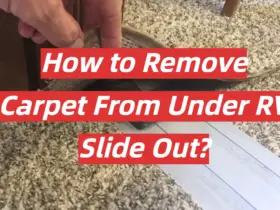
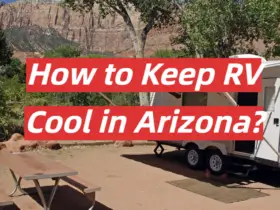
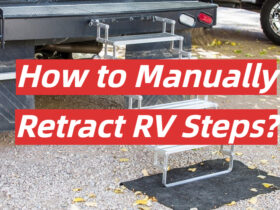
Leave a Reply